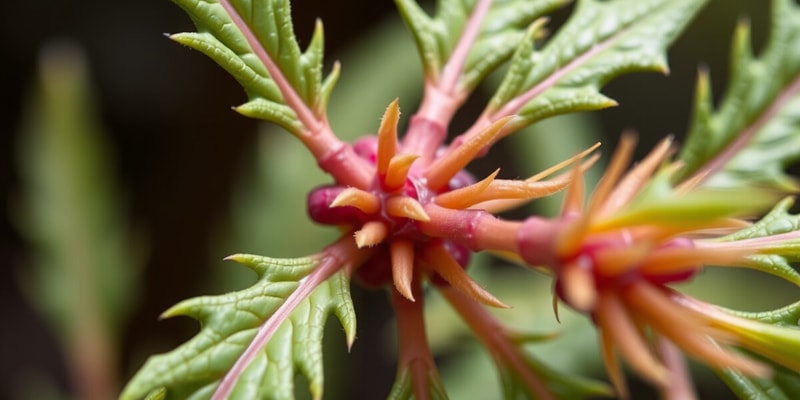Podcast
Questions and Answers
What is a primary advantage of the C4 pathway in plants?
What is a primary advantage of the C4 pathway in plants?
How do CAM plants minimize water loss during photosynthesis?
How do CAM plants minimize water loss during photosynthesis?
In what type of environment are CAM plants predominantly found?
In what type of environment are CAM plants predominantly found?
What triggers some plants to switch from the C3 pathway to the CAM pathway?
What triggers some plants to switch from the C3 pathway to the CAM pathway?
Signup and view all the answers
How does the Crassulacean Acid Metabolism (CAM) support photosynthesis in aquatic environments?
How does the Crassulacean Acid Metabolism (CAM) support photosynthesis in aquatic environments?
Signup and view all the answers
What is a characteristic feature of plants using the C4 photosynthetic pathway?
What is a characteristic feature of plants using the C4 photosynthetic pathway?
Signup and view all the answers
Which of the following best describes facultative CAM plants?
Which of the following best describes facultative CAM plants?
Signup and view all the answers
What role does high CO2 concentration have on photorespiration?
What role does high CO2 concentration have on photorespiration?
Signup and view all the answers
What distinguishes CAM plants from C3 and C4 plants during the day?
What distinguishes CAM plants from C3 and C4 plants during the day?
Signup and view all the answers
What is one significant feature of morphological adaptations in heterotrophs?
What is one significant feature of morphological adaptations in heterotrophs?
Signup and view all the answers
What is the primary energy yield of heterotrophs when consuming organic compounds?
What is the primary energy yield of heterotrophs when consuming organic compounds?
Signup and view all the answers
Why do herbivores typically consume more biomass than carnivores?
Why do herbivores typically consume more biomass than carnivores?
Signup and view all the answers
What factor primarily influences the energy content derived from food for heterotrophs?
What factor primarily influences the energy content derived from food for heterotrophs?
Signup and view all the answers
How do archaea, bacteria, and fungi digest their food?
How do archaea, bacteria, and fungi digest their food?
Signup and view all the answers
What evolutionary advantage is linked to the development of mobility in animals?
What evolutionary advantage is linked to the development of mobility in animals?
Signup and view all the answers
What type of compounds generally serve as poor energy sources for heterotrophs?
What type of compounds generally serve as poor energy sources for heterotrophs?
Signup and view all the answers
Which of the following adaptations in animals reflects their dietary specializations?
Which of the following adaptations in animals reflects their dietary specializations?
Signup and view all the answers
What role do microorganisms play in bioremediation?
What role do microorganisms play in bioremediation?
Signup and view all the answers
What is a common characteristic of all insects regarding food consumption?
What is a common characteristic of all insects regarding food consumption?
Signup and view all the answers
Which organisms primarily depend on excreting enzymes for nutrition?
Which organisms primarily depend on excreting enzymes for nutrition?
Signup and view all the answers
What does it imply when both axes of a plot are log-scaled?
What does it imply when both axes of a plot are log-scaled?
Signup and view all the answers
Why does the heat produced by metabolism proportionally relate to an organism's volume?
Why does the heat produced by metabolism proportionally relate to an organism's volume?
Signup and view all the answers
According to the content, what scaling would be expected for metabolic rate in relation to mass?
According to the content, what scaling would be expected for metabolic rate in relation to mass?
Signup and view all the answers
What primary limitation is indicated to influence the 3/4 scaling of metabolic rate?
What primary limitation is indicated to influence the 3/4 scaling of metabolic rate?
Signup and view all the answers
Which of the following statements about scaling is true based on the content?
Which of the following statements about scaling is true based on the content?
Signup and view all the answers
What does the equation B∝M2/3 signify in terms of metabolic scaling?
What does the equation B∝M2/3 signify in terms of metabolic scaling?
Signup and view all the answers
What geometric principle is considered when examining the scaling differences between surface area and volume?
What geometric principle is considered when examining the scaling differences between surface area and volume?
Signup and view all the answers
What is the dimensionality of the distribution channels that facilitate materials throughout the body according to fractal geometry?
What is the dimensionality of the distribution channels that facilitate materials throughout the body according to fractal geometry?
Signup and view all the answers
Which of the following reflects the concept of metabolic scaling accurately?
Which of the following reflects the concept of metabolic scaling accurately?
Signup and view all the answers
How does the surface area-to-volume relationship impact larger organisms?
How does the surface area-to-volume relationship impact larger organisms?
Signup and view all the answers
What digestive adaptation is primarily found in herbivores to help process fiber-rich diets?
What digestive adaptation is primarily found in herbivores to help process fiber-rich diets?
Signup and view all the answers
How do ruminants benefit from rumination?
How do ruminants benefit from rumination?
Signup and view all the answers
Which of the following choices best exemplifies Kleiber's Law?
Which of the following choices best exemplifies Kleiber's Law?
Signup and view all the answers
What is a primary characteristic of heterotrophy in multicellular animals?
What is a primary characteristic of heterotrophy in multicellular animals?
Signup and view all the answers
Which factor does NOT influence an animal's digestive adaptations?
Which factor does NOT influence an animal's digestive adaptations?
Signup and view all the answers
What is coprophagy and why is it significant in some herbivores?
What is coprophagy and why is it significant in some herbivores?
Signup and view all the answers
What is the relevance of species' body mass in terms of metabolic rate according to Kleiber's findings?
What is the relevance of species' body mass in terms of metabolic rate according to Kleiber's findings?
Signup and view all the answers
Which type of organisms primarily benefit from a relationship with bacterial symbionts?
Which type of organisms primarily benefit from a relationship with bacterial symbionts?
Signup and view all the answers
What physiological process corresponds to 'heterotrophy' in organisms?
What physiological process corresponds to 'heterotrophy' in organisms?
Signup and view all the answers
Study Notes
Photosynthetic Pathways
- C4 Pathway: Uses more ATP but has better efficiency in high temperatures compared to C3 plants; minimizes transpiration losses by utilizing PEPcase to absorb CO2 when stomates are partially open.
- Climatic Patterns: C4 plant dominance is predictable by climate, with increased temperature correlating with a higher proportion of C4 species.
- Crassulacean Acid Metabolism (CAM): Opens stomates at night to minimize water loss, using PEPcase to fix CO2 into 4-carbon organic acids, stored in vacuoles for daytime use in the Calvin cycle.
- CAM Plant Characteristics: Often succulent and found in arid or saline environments but also in humid tropics as epiphytes and some aquatic plants, improving CO2 uptake in low concentrations.
- Facultative CAM: Some plants can switch between C3 and CAM pathways based on water availability, optimizing carbon gain when conditions permit.
Heterotrophy
- Definition: Heterotrophs convert energy-rich organic compounds (food) into usable chemical energy (ATP).
- Food Chemistry: Energy gain varies based on food chemistry, with carbohydrates, proteins, and fats being the most energy-rich; fiber (e.g., cellulose) is difficult to digest for most heterotrophs.
- Energy Cost of Feeding: Soil microorganisms require less energy to find low-energy food, while carnivores, like cheetahs, expend more energy for a high-energy meal.
- Digestive Adaptations: Variability in digestive systems allows more efficient assimilation of energy and nutrients; herbivores have longer digestive tracts to process fibrous plant materials.
- Symbiotic Relationships: Many herbivores rely on bacteria to assist in cellulose breakdown, exemplified by ruminants with specialized stomach compartments for fermentation and rumination.
Metabolism and Scaling
- Metabolism Definition: Total energy expenditure for physiological processes, affecting organismal ecology.
- Kleiber's Law: Describes the relationship of metabolic rate (heat produced per day) to body mass, demonstrating a log-log scaling where metabolic rate and body size have a linear relationship.
- Surface Area vs. Volume: As organisms grow, their volume increases faster than their surface area, posing challenges for heat dissipation from metabolic processes.
- Scaling Expectations: The metabolic rate should scale with body mass (M) tuned down by an exponent of 2/3 to prevent overheating.
- Fractal Branching: A better scaling of 3/4 arises from the distribution of materials through bodies, influenced by fractal geometries which enhance the efficiency of nutrient and waste transport.
Studying That Suits You
Use AI to generate personalized quizzes and flashcards to suit your learning preferences.
Related Documents
Description
Explore the intricacies of photosynthetic pathways, including C4 and CAM processes, and their adaptations to environmental conditions. This quiz delves into how different plant species optimize carbon uptake and water usage. Discover the role of heterotrophy in energy conversion in organisms.




